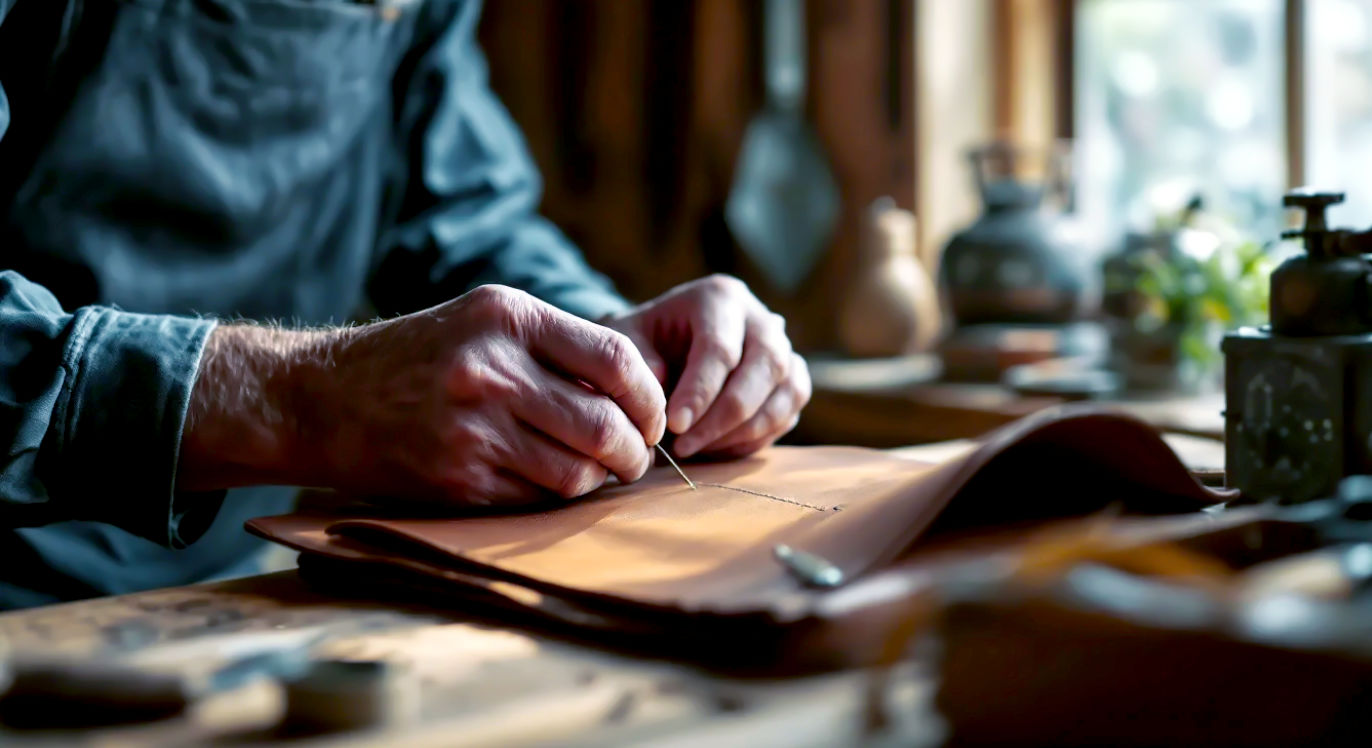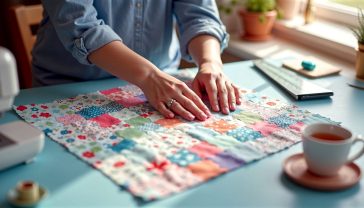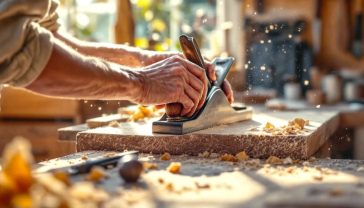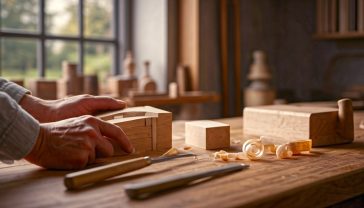Handcrafted in Britain: The Renaissance of Artisanal Leather Goods
A deep dive into the world of British artisanal leather. Explore the history, techniques, and the makers behind the craft’s modern renaissance.

This post may contain affiliate links. If you make a purchase through these links, we may earn a commission at no additional cost to you.
There’s a certain magic to real leather. It’s not just the rich, earthy smell or the way it warms to your touch. It’s the story it tells. In a world of fast fashion and throwaway culture, a beautifully made leather bag, belt, or pair of shoes feels different. It feels real. And nowhere is this truer than in Britain, where a quiet revolution is taking place. After decades of being pushed aside by cheaper imports, traditional leather craftsmanship is making a serious comeback.
This isn’t just about posh shops in London, though they play their part. All across the country, in small workshops tucked away in rural villages and bustling city mews, artisans are turning hide into treasure. They’re using skills passed down through generations, combined with a fresh, modern eye for design. It’s a world where quality isn’t just a buzzword; it’s a promise, stitched into every single piece.
This is the story of that renaissance. We’ll journey back in time to discover Britain’s deep history with leather, from the Roman tanneries to the clatter of Victorian factories. We’ll step inside the modern workshop, revealing the incredible skill, patience, and passion that goes into making a single handcrafted item. We’ll help you spot the difference between the genuine article and a cheap imitation, and give you the confidence to invest in a piece you’ll love for a lifetime. Forget fleeting trends; this is about timeless style, sustainable quality, and the enduring spirit of British craftsmanship.
The Soul of the Hide: What Makes British Leather So Special?
Before we dive into the workshops, let’s get to grips with the material itself. Not all leather is created equal. The cheap, plastic-feeling stuff you find on the high street is a world away from the material our British artisans work with. Understanding the difference is the first step to appreciating true quality.
From Field to Workshop: Sourcing the Finest Hides
The journey of a leather bag starts long before it’s cut or stitched. It begins in a field. The best British leather goods often start with British hides. Our island’s climate is perfect for raising healthy cattle with strong, supple skins.
- Traceability is Key: Many top-tier makers can tell you exactly which farm their leather came from. This isn’t just a nice story; it’s a guarantee of quality and ethical sourcing. They look for hides from animals that have been well cared for, as stress and poor conditions can damage the skin.
- Heritage Breeds: Some artisans seek out leather from traditional British cattle breeds. Think of the deep, rich hides from a Hereford or the uniquely textured skin of a Highland cow. These hides have character you just can’t replicate.
The Ancient Art of Tanning: Turning Skin into Leather
A raw hide is just that—a skin. To turn it into the durable, beautiful material we know as leather, it has to be tanned. This is a crucial process that stops the hide from rotting and gives it its unique properties. In Britain, two main methods have stood the test of time.
Vegetable Tanning: The Slow, Traditional Method
Imagine soaking a hide in a bath of natural goodness—things like tree bark (especially oak), leaves, and fruits. That’s the essence of vegetable tanning, or ‘veg-tan’.
- What it is: This is the old-school way, a process that can take weeks or even months. The tannins (natural chemicals) from the plant materials slowly penetrate the hide, preserving it and giving it a firm, sturdy feel.
- Why it’s special: Veg-tanned leather has a wonderful, natural smell. It starts off quite stiff but softens beautifully over time, developing a unique patina—that gorgeous, aged look that tells the story of its use. It’s the leather of choice for traditional items like sturdy belts, briefcases, and classic satchels. There are only a handful of traditional oak bark tanneries left in Britain, like J. & F.J. Baker & Co in Devon, which has been tanning for over 500 years. Their methods are a living piece of history.
Chrome Tanning: The Modern, Faster Alternative
Developed in the mid-19th century, chrome tanning was a game-changer. It’s much faster and produces a different kind of leather.
- What it is: This method uses chromium salts to tan the hide, a process that can be completed in as little as a day.
- Why it’s used: Chrome-tanned leather is much softer and more flexible from the start. It’s also more resistant to water and heat and can be produced in a huge range of vibrant colours. You’ll find it used for things like car upholstery, soft handbags, and clothing.
Neither method is inherently ‘better’—they’re just different. However, for the artisans at the heart of the British leather renaissance, the character, sustainability, and ageing potential of veg-tanned leather often hold a special appeal.
Understanding the Cuts: Not All Parts of the Hide are the Same
When you hear terms like ‘full-grain’ or ‘genuine leather’, what do they actually mean? This is where many brands try to confuse customers.
- Full-Grain Leather: This is the absolute best of the best. It’s the top layer of the hide, with all its natural markings and imperfections left intact. It’s incredibly strong and durable. When you run your hand over it, you can feel the natural texture. This is the stuff that develops that beautiful patina.
- Top-Grain Leather: This is the second-best quality. The very top surface has been sanded or buffed to remove any imperfections. It’s still a great, strong leather, but it doesn’t have the same unique character as full-grain and won’t age in quite the same way.
- ‘Genuine’ or Corrected-Grain Leather: This sounds good, but it’s often a sign of lower quality. This is leather made from the lower layers of the hide. Its surface is usually sanded down completely and then an artificial grain pattern is stamped onto it. It’s weaker and has a more uniform, plastic-like feel.
- Bonded Leather: This is the lowest grade. It’s basically the leftover scraps and dust from the leather-making process, shredded and glued together onto a backing sheet. It’s weak, peels easily, and shouldn’t really be called leather at all.
For true British artisans, full-grain leather is the only choice. They embrace the natural scars, wrinkles, and marks on the hide, seeing them not as flaws, but as signs of a life lived—a testament to the material’s authenticity.
A Stitch in Time: Britain’s Long and Storied Love Affair with Leather
To understand today’s revival, you have to appreciate just how deep our roots with leather go. It’s a story woven into the very fabric of the nation, from the sandals of Roman soldiers to the saddles of kings.
From Roman Sandals to Medieval Guilds
When the Romans arrived, they brought their advanced tanning techniques with them. Archaeologists have found ancient tanneries in places like London and York, with preserved leather shoes and military gear, perfectly crafted for British conditions.
Fast forward to the Middle Ages, and leatherworking was a cornerstone of society. Towns like Walsall, Northampton, and Chester became famous for their leather goods. Powerful guilds were formed—exclusive clubs for master craftsmen. The Worshipful Company of Cordwainers (makers of fine shoes) and the Worshipful Company of Saddlers in London were like the Premier League of their day. They set incredibly high standards, controlled who could practice the trade, and ensured that ‘Made in Britain’ meant something.
The Industrial Revolution: Boom and Bust
The 18th and 19th centuries changed everything. The roar of machines replaced the quiet tap of the artisan’s hammer. Huge factories sprang up, especially in the Midlands. Northampton became the undisputed boot and shoe capital of the world, its factories churning out millions of pairs for everyone from British soldiers to dapper city gents. Walsall was the heart of the saddlery and harness trade, equipping the British Empire’s cavalry and carriages.
This was a time of immense prosperity, but it also sowed the seeds of decline. The focus shifted from individual skill to mass production. While quality was still high—the Goodyear welting method, a sign of top-quality shoe construction, was perfected here—the intimate connection between maker and product began to fade.
The 20th Century Challenge and the Seeds of Revival
After the Second World War, things got tough. Cheaper manufacturing abroad, changing fashions (goodbye horses, hello cars), and the rise of synthetic materials hit the British leather industry hard. One by one, the great factories and tanneries closed their doors. It seemed as though centuries of skill were about to be lost forever.
But a few hardy souls held on. Small family firms, bespoke makers, and stubborn traditionalists refused to let the craft die. They kept the old ways alive, quietly making exceptional goods for those who still valued quality. It was these flickering embers that would eventually ignite the renaissance we are seeing today.
The Modern Workshop: Where Passion and Precision Meet
Step inside a modern British leather workshop, and you’ll find a place that is both a time capsule and a hub of modern design. The air smells of leather, wax, and woodsmoke. Tools that wouldn’t look out of place in a museum hang neatly on the walls. But alongside them, you’ll see sleek laptops and cutting-edge designs. This is where tradition gets a 21st-century makeover.
The Artisan’s Toolkit: Heirlooms of the Trade
The tools are the first thing you’ll notice. Many are decades, or even centuries, old, passed down from master to apprentice. They have a weight and a history that modern tools lack.
- Cutting Tools: Forget scissors. Artisans use razor-sharp knives. A round knife (or head knife) with its curved blade is used for cutting large shapes, while a smaller clicking knife is perfect for precise curves and details.
- Stitching Tools: The most iconic tool is the stitching clam (or pony), a wooden clamp held between the knees to keep the leather steady. Holes are marked with a pricking iron and then individually pierced with a sharp awl.
- Finishing Tools: A bone folder is used to crease and smooth edges, while various edge bevellers and burnishers create those perfectly rounded, polished edges that scream quality.
The Art of the Hand-Stitch: Stronger, Better, Slower
Perhaps the single biggest difference between a handcrafted item and a factory-made one is the stitching. A sewing machine uses a ‘lock stitch’, where two threads lock together in the middle of the leather. If one of these threads breaks, the whole seam can quickly unravel.
Artisans use a technique called saddle stitching.
- How it works: Using a single long thread with a needle at each end, the artisan passes the threads through the same hole from opposite sides, creating a knot within each and every stitch.
- Why it’s superior: This method is incredibly strong. If one stitch were to ever break (which is highly unlikely), the rest of the seam would hold firm. It’s a slow, painstaking process—stitching a single bag can take many hours—but the result is a product of unrivalled durability. It’s a visible mark of true craftsmanship.
Burnishing the Edges: The Signature of Quality
Look at the edge of a cheap leather belt. It’s often painted with a sort of plastic coating that will eventually crack and peel. Now look at the edge of a handcrafted piece. It will be smooth, rounded, and have a subtle sheen. This is a burnished edge.
This process involves sanding the edge smooth, applying water or a natural gum (like gum tragacanth), and then rubbing it vigorously with a piece of canvas or a wooden tool. The friction and heat seal the leather fibres, creating a beautiful, hard-wearing finish that will last as long as the product itself. It takes time and effort, and it’s a detail that mass-producers always skip.
The New Wave: Meet the Makers Behind the Revival
The British leather renaissance isn’t being driven by big corporations. It’s a grassroots movement, led by a diverse group of passionate individuals.
The Heritage Keepers
Some workshops are institutions. Think of brands like Launer London, who have been making handbags for Her Majesty The Queen for over 50 years, or Swaine Adeney Brigg, creators of the iconic attaché cases seen in James Bond films. These companies have a rich history but have adapted to the modern world, combining their peerless heritage with contemporary demands. They are the guardians of the flame.
The Sole Proprietors: From Hobby to Profession
Many of the most exciting new makers started small. They might have taken a weekend course, fallen in love with the craft, and gradually turned a passion into a profession. Often working from a shed at the bottom of the garden or a small studio space, these artisans are redefining what a luxury brand can be.
They connect directly with their customers, often through social media platforms like Instagram, where they can showcase their process and tell their story. This creates a powerful connection. When you buy from them, you’re not just buying a product; you’re buying a piece of their passion and supporting a small, independent British business. A great example is Otterley Leather in Rutland, where a single maker creates stunning, minimalist goods built to last a lifetime.
The Design Innovators
This new wave isn’t just about recreating old designs. A new generation of designer-makers is pushing the boundaries of what can be done with leather. They are blending traditional techniques with bold, modern aesthetics. Think minimalist wallets with clever construction, architectural handbags in unexpected colours, or collaborations with artists and illustrators. They respect the past but are not bound by it, ensuring that British leathercraft remains relevant and exciting for the future.
How to Be a Savvy Shopper: A Guide to Buying British Leather
Ready to invest in a piece of British craftsmanship? It’s a rewarding experience, but it pays to know what you’re looking for. Here’s how to spot true quality and make a purchase you’ll treasure.
Tip 1: Use Your Senses
True quality is something you can see, feel, and even smell.
- Smell it: Good quality, vegetable-tanned leather has a rich, earthy, slightly sweet smell. If it smells of chemicals or plastic, walk away.
- Touch it: Full-grain leather has a natural, textured feel. It might have small imperfections. It shouldn’t feel perfectly smooth or plastic-like. Press your nail into it gently; it should leave a mark that slowly fades, showing the leather has natural oils and isn’t coated in plastic.
- Look closely: Examine the grain. Can you see the natural pores and markings? Look at the stitching. Is it perfectly even and slightly angled? That’s the sign of hand-stitching. Check the edges. Are they smooth and polished, or painted and plasticky?
Tip 2: Check the ‘Three Cs’: Construction, Components, and Country of Origin
- Construction: How is it put together? Are the stress points (like where a handle joins a bag) reinforced with extra stitching or rivets? Does it feel solid and well-balanced?
- Components: Quality doesn’t stop at the leather. Check the hardware. Is the buckle made of solid brass or cheap plated metal? Is the zip a sturdy, well-known brand like YKK, or a flimsy, unbranded one?
- Country of Origin: Be wary of vague labels. A brand might be ‘designed in Britain’ but actually made elsewhere. Look for clear statements like ‘Handmade in England’ or ‘Crafted in Scotland’. True artisans are proud of their roots and will say so.
Tip 3: Think About Cost vs. Value
A handcrafted British leather item is an investment. It will undoubtedly cost more than a mass-produced equivalent. But think about it in terms of cost per use.
That £30 high-street bag might fall apart after a year or two. A £300 handcrafted satchel, on the other hand, could easily last you 30 years or more. Over its lifetime, it actually works out to be far better value. You are paying for time, skill, and materials that are designed to endure, not to be replaced.
Caring for Your Investment
Once you’ve bought your beautiful piece, a little care will go a long way.
- Keep it Clean: Wipe it down with a soft, damp cloth every now and then.
- Condition it: Once or twice a year, apply a good quality leather conditioner or balm. This feeds the leather, keeping it supple and preventing it from drying out. Think of it like moisturising your own skin.
- Embrace the Patina: Don’t panic about every little scratch or scuff. These marks are part of your story, contributing to the unique patina that will make your item truly yours. A well-loved leather piece looks a hundred times better than one that’s been kept pristine in a box.
The Future is Handmade: Why British Craftsmanship Matters More Than Ever
In a world grappling with the environmental cost of fast fashion, the renaissance of British leathercraft feels more important than ever. It offers a powerful alternative: a return to buying less but buying better.
- Sustainability: This is the ultimate slow fashion. By using locally sourced hides and natural tanning processes, and by creating products that last for generations, artisans are promoting a more sustainable way of living. A single, well-made bag can replace dozens of cheap, disposable ones.
- Supporting Local Economies: When you buy from a British maker, your money isn’t going to a faceless multinational corporation. It’s going to a real person, paying their mortgage, supporting their family, and keeping traditional skills alive in your local community.
- A Human Connection: In an increasingly digital world, there’s a deep satisfaction in owning something made by a human hand. You can see the skill, feel the passion, and appreciate the hours of dedication that have gone into its creation. It’s an object with a soul.
The quiet hum of the workshop is getting louder. The smell of oak bark and beeswax is drifting back into our towns and villages. The British artisan is back, not as a relic of the past, but as a beacon for a more thoughtful, sustainable, and beautiful future. The renaissance is here, and it’s built to last.
Further Reading & Resources
For those wishing to explore further, these resources represent some of the most respected voices and institutions in the British leather industry:
- The Worshipful Company of Leathersellers: One of the ancient Livery Companies of the City of London, promoting and supporting the leather industry. https://leathersellers.co.uk/
- The Museum of Leathercraft, Northampton: An excellent resource for the history and craft of leatherworking in Britain. https://museumofleathercraft.org/
- Heritage Crafts: A charity dedicated to supporting and promoting traditional craftsmanship in the UK, including leatherwork. https://heritagecrafts.org.uk/






